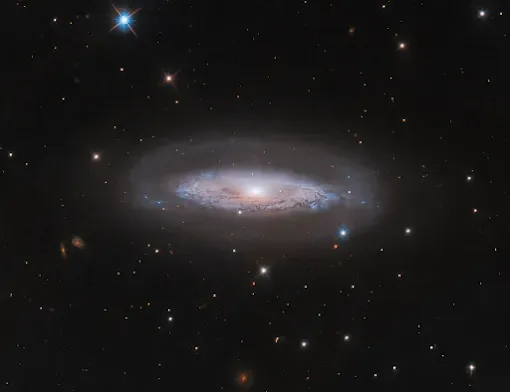Hubble Examines a Busy Galactic Center: A Closer Look at the Universe’s Crowded Heart
The Hubble Space Telescope, one of the most significant astronomical tools ever created, has once again provided us with awe-inspiring images and data—this time, focusing on the bustling heart of a galaxy. This exploration sheds new light on what happens at the center of these massive cosmic structures and why they are so vital in our understanding of the universe.
What Is a Galactic Center?
At the center of most galaxies, including our own Milky Way, lies a region known as the galactic center. This area is not just dense with stars and interstellar gas, but often contains a supermassive black hole. These regions are incredibly active, with stars being born and destroyed in large numbers. Understanding the dynamics at the heart of galaxies helps astronomers explore everything from star formation to the gravitational forces that shape galaxies.
Hubble's Latest Discovery
The Hubble Space Telescope recently focused on a particularly busy galactic center in a distant galaxy, capturing an intricate web of activity. This new image reveals bright clusters of stars swirling in chaotic orbits, streams of gas lit by glowing young stars, and the unmistakable dark pull of a central black hole.
These images are essential for astronomers who aim to better understand how galaxies evolve and interact. For example, the massive gravitational forces at play in the center can shape the behavior of everything from small stars to entire solar systems. Moreover, by studying these central regions, scientists can gain insight into how galaxies merge and form larger structures.
What Makes Hubble’s Observations Special?
Hubble’s ability to capture light across multiple wavelengths, from visible to ultraviolet, allows it to offer a detailed view of objects that are otherwise obscured by dust and gas. Galactic centers, particularly in their active stages, often have so much interstellar material swirling around that ground-based telescopes struggle to provide clear images. Hubble’s positioning in space bypasses this problem, giving scientists an unobstructed view.
By analyzing the data, astronomers can observe the interaction between stars, gas, and black holes. One of the key interests is understanding how supermassive black holes affect their surroundings. In this particular galactic center, it appears that the black hole is feeding on the surrounding gas, a process known as "accretion," which powers immense energy releases.
Galactic Centers: The Cosmic Laboratories
Galactic centers are sometimes referred to as "cosmic laboratories" due to the extreme conditions present. Here, stars move at incredible speeds, black holes can grow millions of times larger than our sun, and the birth and death of stars occur at a rapid pace. These environments are perfect for testing theories about the fundamental forces of the universe, like gravity and electromagnetism.
The insights provided by Hubble’s observations in this busy galactic center will contribute to ongoing research on galaxy formation, black hole growth, and star lifecycle. It will also assist scientists in comparing the activity of different galactic centers across the universe.
Why Does It Matter?
Understanding galactic centers helps answer some of the universe’s most pressing questions. These regions are crucial for comprehending how galaxies like our own formed and evolved over billions of years. By studying the processes occurring there, astronomers can predict how galaxies will continue to evolve in the future.
Additionally, galactic centers hold clues about the mysterious dark matter and dark energy that make up most of the universe. Observing how stars and gas move around the center of galaxies gives astronomers indirect evidence of these elusive phenomena.
Final Thoughts
The Hubble Space Telescope continues to push the boundaries of what we know about the universe, and its examination of busy galactic centers is no exception. With each new observation, we get closer to unlocking the secrets of our cosmic origins and the forces that shape the universe.
Hubble’s latest findings remind us that while we’ve come a long way in understanding our universe, there is still so much left to discover. The galactic center, with its dense collection of stars, gas, and black holes, remains one of the most fascinating and mysterious regions of space.4o



Post a Comment